This Red Peppers in Mustard Sauce recipe offers a wonderful method for preserving the vibrant flavors of peppers to enjoy during the colder months. With a sweet and tangy taste, these preserved peppers make an excellent accompaniment to hearty roasted meats, such as pork or beef.
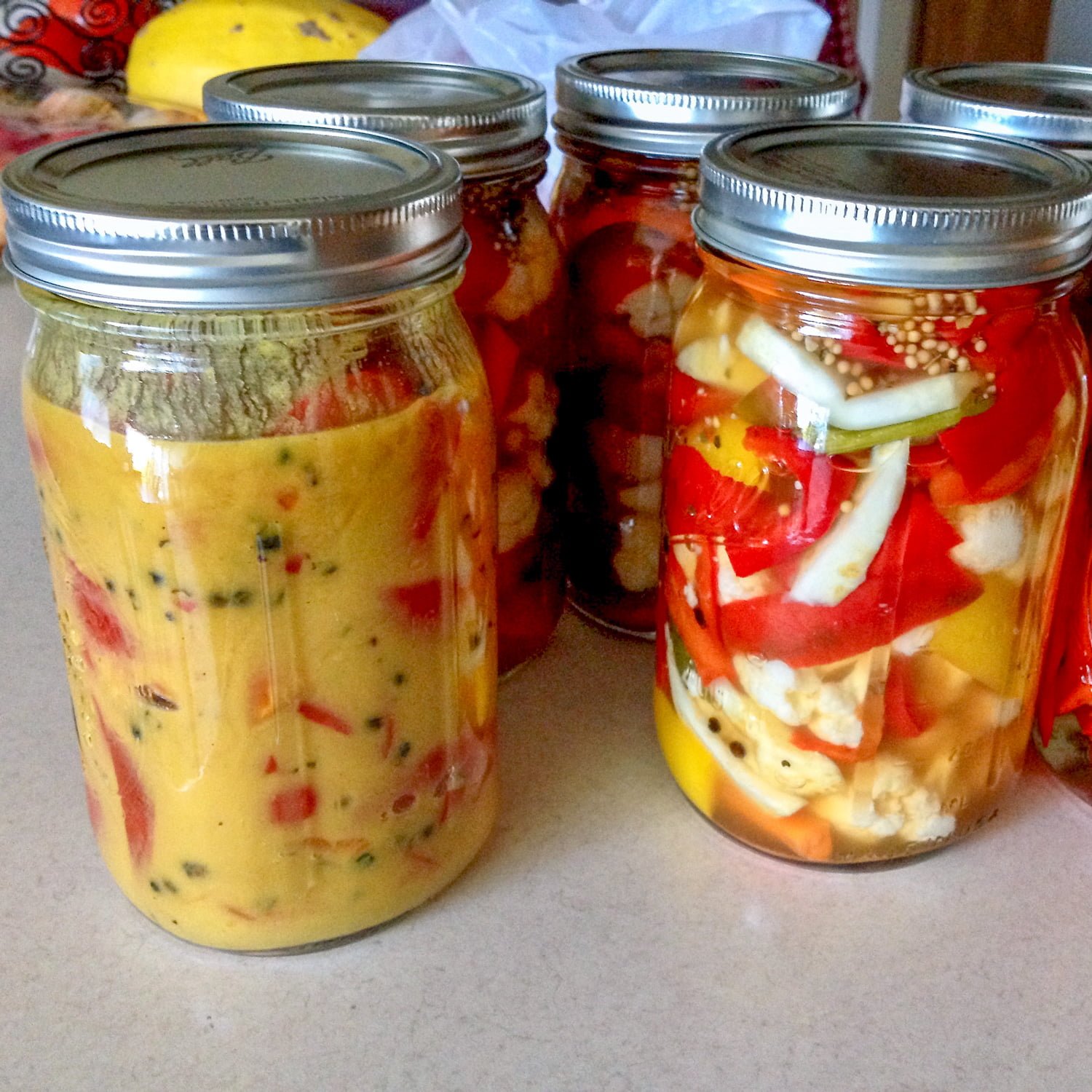
It is that time of the year when I feel the urge to canning. The crisp air of September is here, and vegetables can be found in abundance at the Farmers Market. Here in Minnesota, we have to take advantage of the short summers. The Farmers Market opens in June and closes at the beginning of October, so if I want to can vegetables for the cold days, this is the time.
I used to preserve lots of vegetables for winter many years ago. Canning was a way of surviving winters, as the grocery stores did not carry any fresh produce from October to April. It was mandatory if we wanted to stay healthy in the winter.
Nowadays, canning is just a hobby and a way of keeping my traditions and memories alive. We can find anything we need at the grocery stores, but why not take advantage of the cheaper vegetables from the Farmer's Market?
This is the time to preserve the sweet peppers, the fresh tomatoes, and the gorgeous eggplants my way, without chemicals, preservatives, and other non-food-related ingredients.
Jump to:
What Is This Recipe For Peppers In Mustard Sauce?
This recipe is a unique dish that combines the sweetness of red bell peppers with the bold tanginess of mustard sauce. The peppers are washed, sliced, and then immersed in a sauce made from yellow mustard, vinegar, honey, and seasonings.
The result is a mouthwatering condiment that perfectly balances sweet and savory flavors, and it can be used as a condiment or as a side dish.
The vinegar, salt, and honey, maintain the freshness of the peppers for at least four or five months, which allows you to enjoy their exquisite taste all winter long.

Whether as a topping, a side, or a flavor enhancer, this recipe has the essence of Eastern European culinary traditions and is a wonderful addition to any meal.
Key ingredients:
- Red Bell Peppers: Sweet and vibrant, red bell peppers add color and flavor. Use yellow or orange bell peppers if red ones aren't available, or use all three of them for a colorful combination.
- Yellow Mustard: Tangy and slightly spicy, yellow mustard provides the sauce's characteristic kick. You can use Dijon mustard for a milder flavor or whole-grain mustard for added texture.
- Vinegar: Vinegar adds acidity and tang to the sauce and also acts as a preservative. I used organic apple cider vinegar, but white wine vinegar or red wine vinegar can also be used.
- Honey: Honey lends natural sweetness to balance the tanginess of the sauce. I used raw organic honey, but regular honey is perfectly acceptable.
- Vegetable oil provides a smooth texture and richness to the sauce. Canola oil, grapeseed oil, or olive oil can also be used.
- Salt: Make sure that the salt you use is iodine-free.
- Peppercorns: add a peppery bite to the sauce.
- Bay leaves: are aromatic, with a subtle herbal flavor that enhances the overall complexity of the mustard sauce.
Sterilize The Jars
Sterilizing jars is an essential step in preserving foods. Here are the updated guidelines for it:
Materials Needed:
- Jars and lids
- Large pot
- Rack or cloth to prevent jars from touching the bottom of the pot
- Tongs or jar lifter
- Boiling water or a dishwasher
Method:
- Wash the Jars: Start by washing the jars, lids, and bands in hot, soapy water. Rinse them thoroughly to remove any soap residue. check for any damage, cracks, chips, or deformities. Damaged jars may not seal properly.
- Boiling Water Bath Method: Place a rack or cloth at the bottom of a large pot to prevent direct contact between the jars and the pot. Arrange the jars on the rack, ensuring they are not touching each other.
- Dishwasher Method:If your dishwasher has a high-temperature setting, you can use it to sterilize jars. Ensure the dishwasher is empty so there's no residue from previous loads. Place the jars, lids, and bands in the dishwasher and run it on the high-temperature cycle.
- Lids and Bands: While the jars are sterilizing, place the lids and bands in a separate saucepan with simmering water. Do not boil them; just keep them hot to soften the rubber seals on the lids.
- Filling: Once you've prepared your recipe and are ready to fill the jars, carefully remove them from the hot water using tongs or a jar lifter. Pour out any excess water from inside the jars.
- Fill and Seal: Fill the jars with your prepared food, leaving the recommended headspace for your specific recipe. Wipe the rims clean with a damp cloth to ensure a proper seal. Place the softened lids on the jars, followed by the bands, and tighten until fingertip-tight.
How To Make These Peppers In Mustard Sauce
Step 1. Wash the peppers and discard the seeds. Cut them in half.

Step 2. Slice the peppers into bite-size pieces and sprinkle some salt over them. Set aside.

Step 3. While the peppers are sitting, make the sauce. In a medium pot, mix mustard, honey, salt, oil, vinegar, bay leaves and peppercorns.

Whisk the sauce to look like a mayo and place it on the stove on medium-low heat. Bring it to a boil, mixing constantly, then simmer the sauce on low heat for about 7-8 minutes.
Step 4. Pour the sauce over the peppers.

Place the pan on the stove and toss the peppers in the sauce for about 5 minutes, on low heat. The goal here is to soften them a little, so they fit better in the jars and the process of pickling starts right away.

Place the peppers in jars and pour the mustard sauce over them.
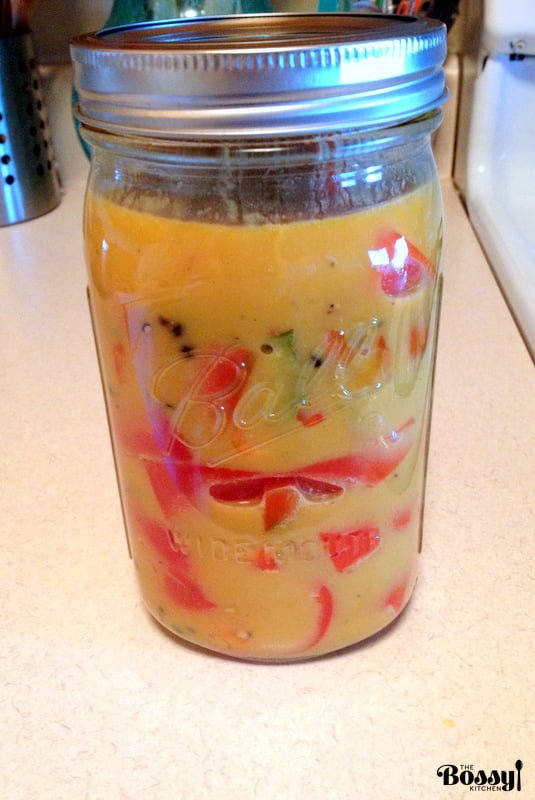
Close and seal the jars and place them upside down.

Cover the jars with thick towels and let them sit on the counter top in the kitchen for 24 hours to cool down.
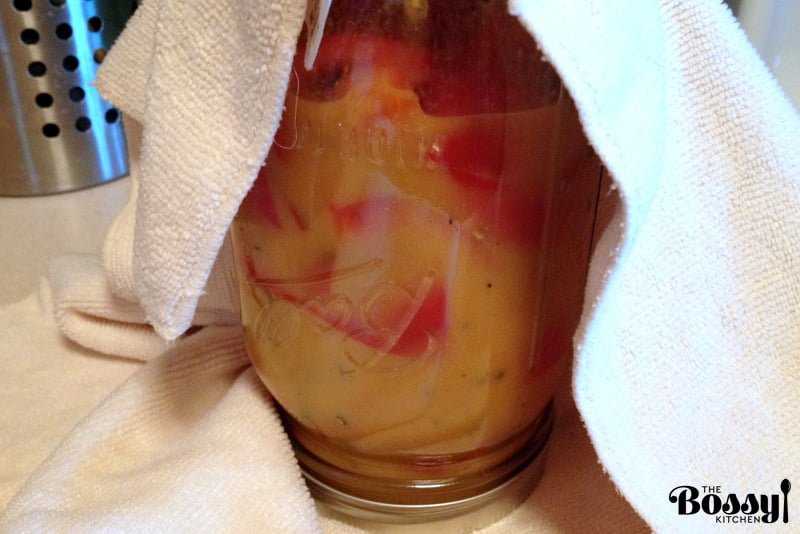
After that, place the jars in a cool place. The peppers should be ready to eat in about a month.
We usually preserve these peppers in September and start eating the vegetables in November around Thanksgiving.

Refrigerate after opening.
Expert tip
It's very important to ensure that the jars are properly sealed immediately after filling and that they are refrigerated after opening.
The Jars Do Nor Require Processing
As the bottom rule, the safety of a recipe in terms of preserving food without processing (e.g., water bath canning or pressure canning) largely depends on the acidity and other preserving agents in the recipe.
In the case of your peppers preserved in mustard sauce, several factors contribute to preserving the peppers without additional processing:
- Vinegar: The organic apple cider vinegar that I used in the recipe is acidic and acts as a preservative. Its acidity helps inhibit the growth of harmful microorganisms. Of course, you can use other types of vinegar, but as long as the vinegar has a minimum of 5% acidity, the peppers are safe to eat.
- Salt: Salt is another preservative in the recipe. It helps draw out moisture from the peppers and creates an environment less conducive to spoilage.
- Honey: Honey, while providing sweetness, also contributes to preservation due to its natural antibacterial properties.
- Mustard: Mustard, especially with its vinegar content, can contribute to preserving the sauce.
How To Serve These Red Peppers In Mustard Sauce
This recipe is great to serve in the winter with roasted meats, but you can have a simple open sandwich, by placing some peppers in the sauce on a piece of good bread. Check out this collection of 34 Best Roasted Pork Recipes For Christmas. The peppers in mustard sauce are perfect for any of these pork recipes.
You can also try to combine it with:
- Roasted Boneless Pork Chops
- Fried Chicken Without Flour
- Beans With Pork Shank In The Crock Pot
- Lemon Rosemary Roasted Chicken With Potatoes And Red Onion
Storage
Cool and Dark Storage: Store your sealed jars in a cool, dark place, such as a pantry or cellar, away from direct sunlight and heat sources. Ideally, the temperature should be between 50°F and 70°F (10°C to 21°C).
While properly preserved foods can last for several years, I recommend to consume this peppers within a year to ensure the best quality and flavor. Preserved peppers in mustard sauce, once opened, should be kept in the fridge and used within a few weeks.
More Recipes To Love
📖 Recipe

Red Peppers in Mustard Sauce
Ingredients
- 1 ½ pounds red bell peppers cut in stripes
- ½ cup yellow mustard
- ¼ cup vinegar your choice (I used organic apple cider vinegar)
- 3 tablespoons raw organic honey
- 2 tablespoons vegetable oil I used olive oil
- 2 tablespoons salt
- 2 tablespoons peppercorns
- 3 bay leaves
Instructions
- Sterilize the jar.
- Wash and clean the red bell peppers. Remove the core and seeds. Slice them in stripes. Set them aside.
Make the mustard sauce:
- In a medium pot, whisk together mustard, honey, salt, oil, vinegar, bay leaves, peppercorns.
- Bring to a boil, then let it simmer for 7-8 minutes. Add the peppers to the sauce and simmer them only 2-3 minutes.
- Remove from the stove and fill up the jar with the peppers. Pour the sauce over the peppers. Close the jar with the lid and flip the jar upside down.
- Cover the jar with towels and keep it covered for 24 hours. Store them in a cool pantry. (Read the notes below)
Notes
- Store the jar in a cool pantry.
- The peppers will be ready to eat in about a month or so. We usually make them in September and use them over the winter.
- Keep the jar refrigerated after opening.
- Good with roasted meats.

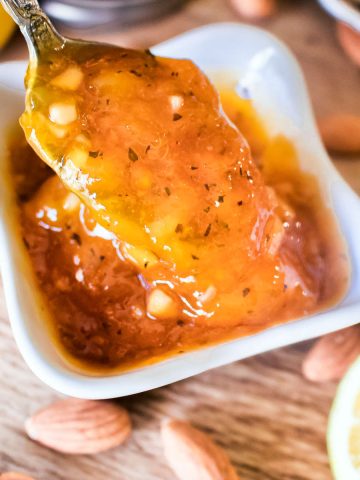

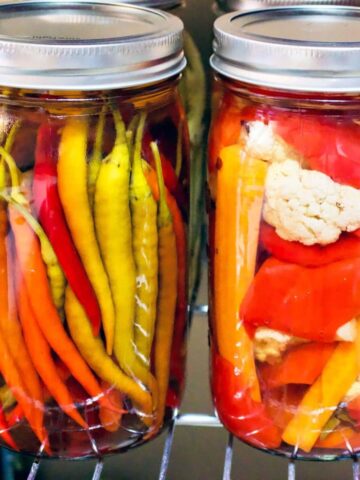
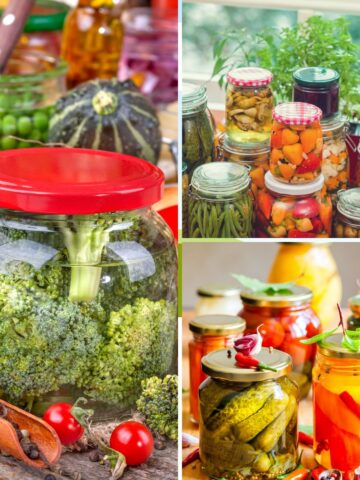


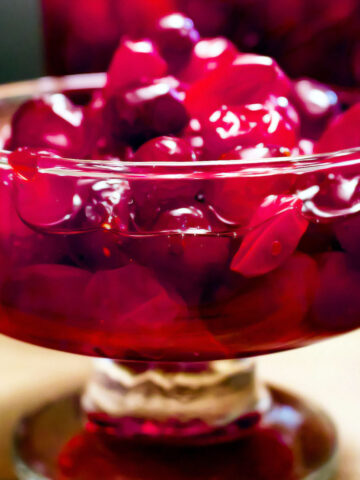

Comments
No Comments